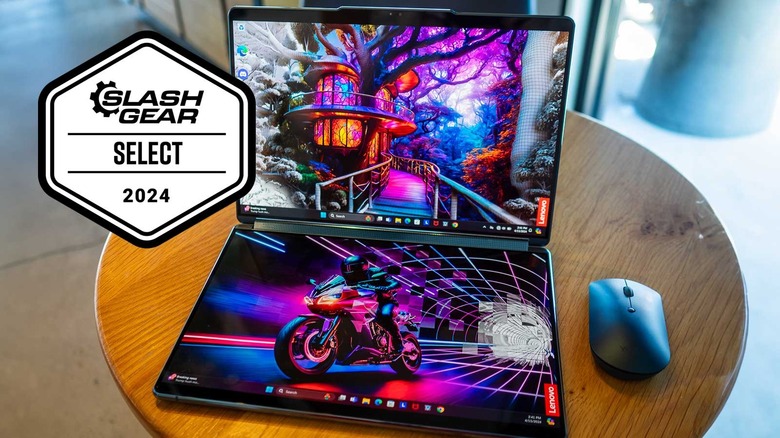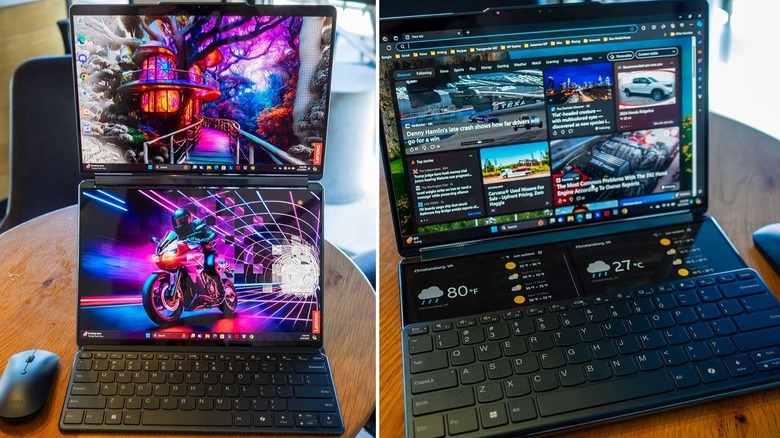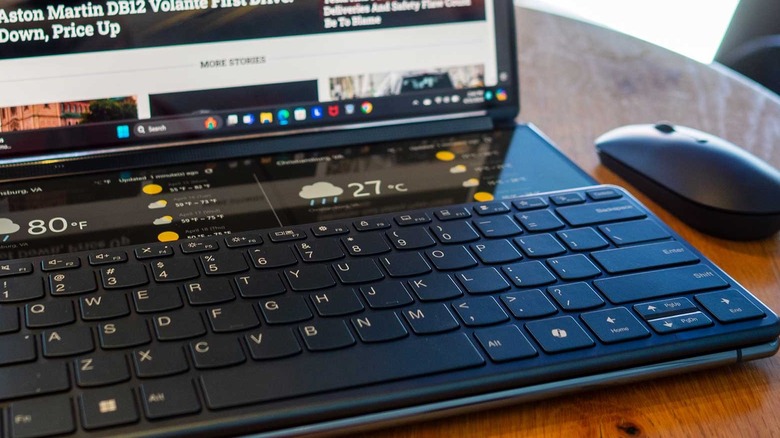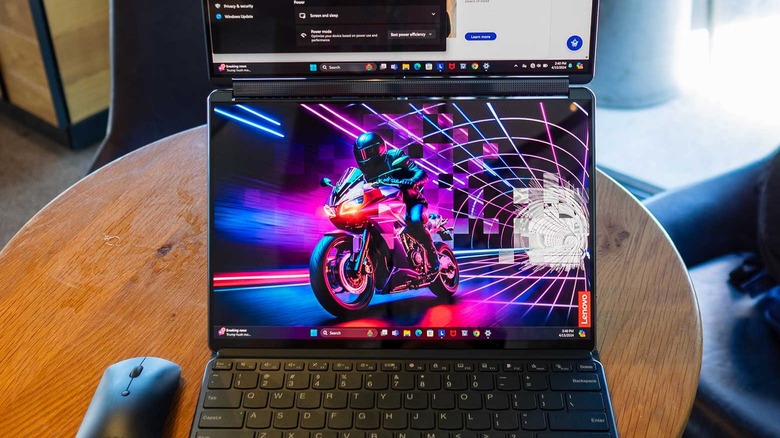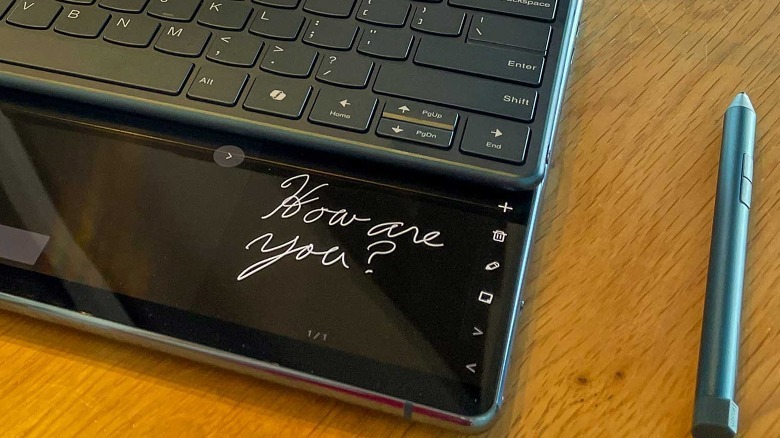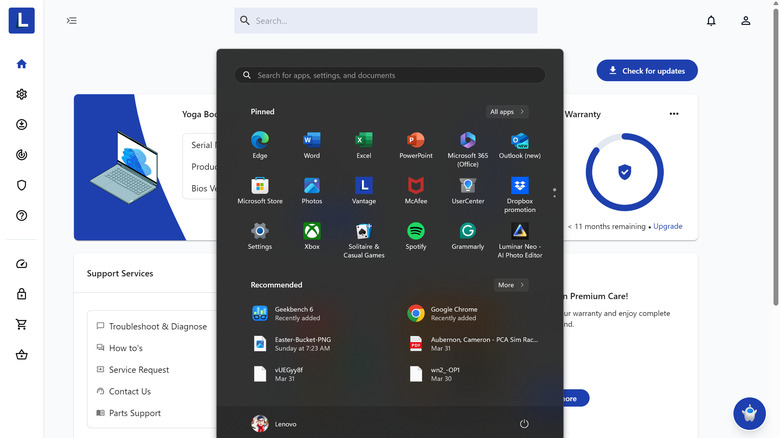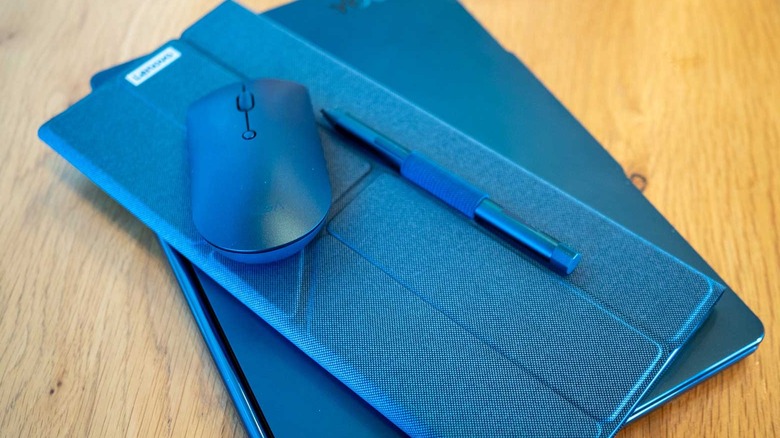Lenovo Yoga Book 9i Gen 9 Review (2024): One Notebook, Two Screens, No Waiting
- Dual-touchscreen setup unique among 2-in-1s
- Brilliant colors from both screens
- Speakers deliver sound to match the stunning visuals
- Optional 1TB SSD offers plenty of storage room
- 16GB RAM is usable, optional 32GB RAM is better, though
- Touchscreen keyboard not for everyone
- Physical keyboard may be too small for some
- Audio volume can be a bit much, even at the lowest settings
- Will need to clean fingerprints off both screens
- Pricey
We may receive a commission on purchases made from links.
When one thinks of Lenovo, the first thought to come to mind is the ThinkPad series of business-grade laptops. However, the Chinese-American multinational tech company isn't just helping captains of industry keep up with the latest and greatest in computing. On the consumer side, Lenovo has the IdeaPad — the consumer version of the ThinkPad — the Legion line of gaming laptops, and the 2-in-1 Yoga. In 2018, the Yoga line introduced a dual-screen laptop in the form of the Yoga Book C930, where one screen was an LCD touch panel, the other an E-Ink unit where the keyboard lived.
Fast forward to 2023, the Yoga Book 9i was the next Yoga 2-in-1 to lose a permanent physical keyboard, this time for a pair of screens a la the Nintendo DS. There is only one other 2-in-1 like the 9i, that being the ASUS ZenBook Duo. Still, this is quite the departure from not only most other 2-in-1s but laptops in general; only the ASUS ROG Zephyrus Duo comes close to these unique dual-screen 2-in-1s, though it still has a permanent physical keyboard.
Unlike the C930, which disappeared without much notice, the Yoga Book 9i is sticking around for 2024 with updates to its processor and storage capacity. How do these improvements stack up to the 2023 edition? And are these improvements worth upgrading for those who have the original on their desks? To find out, Lenovo sent a 2024 Yoga Book 9i Gen 9 for this review.
New processing power, more storage for 2024
There's a lot to unpack with the 2024 edition of the Lenovo Yoga Book 9i 9th Gen. Literally, as this 2-in-1 comes with a few accessories, including a stylus, a Bluetooth mouse, and its physical keyboard. The all-aluminum body is still in the same shade of Tidal Teal as 2023's model, the entire surface anodized via sandblasting for the matte finish it wears. Operating systems are Windows 11 Home or Pro with a trial of Microsoft Office bundled, which is the only difference between the two versions of the 9i 9th Gen available for sale. The physical Bluetooth keyboard and folding stand still perform their fun tricks with the Yoga Book, and the stylus is still useful for everything from signing documents to sketching out ideas for new business concepts.
The biggest change for the 2024 Lenovo Yoga Book 9i is under the hood. Last year's model used the processing power of the 13th-gen Intel Core i7-1355U processor. This year, the Core i7 is out, replaced by the Core Ultra 7 155U, a 14-thread mobile-computing processor with 12 cores (2 performance-oriented, 2 low-power efficient cores, and 8 efficient cores), capable of an Intel Max Turbo processing speed of 4.8 GHz. This output goes through a new set of soldered 16GB LPDDR5x-7467 RAM, replacing the original's -6400 units; you can upgrade to 32GB. The unit reviewed last year came with a 512GB M.2 2242 PCIe 4.0x4 NVMe SSD, though it could also be had with a 1TB SSD unit, which is also true for this year's model.
New processor, better results?
Last time SlashGear reviewed the Lenovo Yoga Book 9i, the Intel Core i7 delivered a GeekBench 6.0.3 multi-core score of 11539, which we said was fine for moderate work, but not for gaming. Does the new Intel Ultra Core processor, then, change things? In some ways, yes. The processor received two scores from the latest version of GeekBench, 6.2.2. The single core score was 2283, and the multi-core score came out to 8099. On paper, this isn't the best set of scores when pegged at GeekBench's standard, the Intel Core i7-12700, and its single-core baseline of 2500. Higher numbers are better, so while the single-core score isn't too far off the mark, the multi-core score is arguably worse; the multi-core baseline is 10780, the score set by the same baseline processor with only 8 cores.
But perhaps there's a better way to think of this dual-screen laptop's purpose away from the numbers. Are you going to play "iRacing" or "World of Warcraft" on the Yoga Book 9i? No. Are you going to do some heavy video editing or graphic design with this flexible laptop? Also, no. But for entertainment purposes, sharing work documents, web browsing and other everyday tasks, the Intel Ultra Core fits right in. All things considered, the Ultra Core is likely a better fit for the 2024 version of the 9i than the original Core i7, since the former is built for mobile computing — the kind that the Yoga Book is meant for — while the latter needs more oomph inside whatever laptop it occupies.
Unique dual-screen computing not for everyone
As mentioned earlier, there are few other laptops like the Lenovo Yoga Book 9i. The biggest draw is the dual-touchscreen surface, which allows users to share projects with everyone in the room. The included keyboard cover doubles as a stand for presentations, with the physical Bluetooth keyboard and mouse ready to guide the visuals along. Of course, the second touchscreen has another trick up its sleeve: place your hands on the screen to activate the virtual keyboard and touchpad.
Those used to typing on such things won't have too much difficulty on the Yoga Book 9i 9th Gen, while most users who prefer knowing exactly where their fingertips are at all times should go ahead and place the Bluetooth keyboard onto the second touchscreen. When they do, two options appear, based on positioning. Place the keyboard at the top, and the virtual touchpad and Lenovo Digital Pen 3 pad are ready to go. Place it at the bottom, and two widgets appear at the top: one for the local weather and another for the news items provided by MSN.
Speaking of the touchscreens, though, users will need to have a few lens-cleaning wipes available, since the displays will attract a few fingerprints. The 60Hz screens offer plenty of bold colors via DisplayHDR True Black 500 paired with Dolby Vision to make any presentation or YouTube video pop. The screens are also both Eyesafe Certified 2.0 and TÜV Rheinland Low Blue Light (Hardware Solution) certified, so your eyes won't hurt on those long Netflix nights. And speaking of, the speakers on the Yoga Book 9i deliver a deep, rich sound to go with those visuals, though you'll want to turn down the volume, as those speakers are plenty loud at the lowest levels.
Two-in-one notebook with features to match
This being a Lenovo product, the Yoga Book 9i 9th Gen (2024) comes with plenty of software tucked away in the SSD, starting with Lenovo's own suite of goodies. Lenovo Vantage presents plenty of info on the 2-in-1, from how much charge is left in the battery to the laptop's temperature and the battery's remaining full charge capacity. There are also trial promotions of McAfee and Dropbox, though you could just download those for yourself. And since there are Microsoft products involved already, the Yoga Book 9i also has the Xbox Game Bar and the Xbox app with the Xbox Game Pass.
That said, if you opt for the base model with the 512 GB SSD, you might be asking why apps like Spotify, Grammarly, and the AI photo editor Luminar Neo are taking up precious space on your Yoga Book's solid state drive. It's not like you asked for these to be there when dropping nearly $2,000 on a niche product of a niche product like this dual-touchscreen wonder. Those who opt to upgrade to the 1TB SSD (a $30 upgrade) may be fine with what's there as far as bloatware goes, but only just.
Lenovo Yoga Book 9i 9th Gen Verdict
The Lenovo Yoga Book 9i 9th Gen (2024) takes what the 2023 version introduced and rearranges things to remain a compelling choice for those looking for something out of the ordinary. After all, its only competitor in the dual-touchscreen laptop game is the aforementioned ASUS ZenBook Duo. The ASUS unit does offer a full-size Bluetooth keyboard with trackpad, HDMI port and a built-in kickstand, a pair of 14-inch touchscreens (compared to the Yoga Book's 13-inch units), and a more powerful Intel Ultra Core 9 processor, all for a starting price of $1,499.99.
Meanwhile, the Yoga Book 9i 9th Gen (2024) starts at $1,980 with Windows 11 Home, 16 GB RAM, 512 GB SSD, and no productivity software installed. It's quite the pricey proposition, for sure, especially with the ZenBook Duo right there for around $500 with more versatility. Not to mention that for the amount of money one could spend on the Yoga Book 9i, you could buy a Lenovo ThinkPad X1 Nano Gen 3 with a little cash left in the bank.
As with the ThinkPad X1 Nano, though, Lenovo is once again a pioneer in a space few other companies have delved into. While many already have 2-in-1s on the market, the Yoga Book 9i takes everything up to 11 with its versatility. Its small size, great portability, and decent specs under the hood ensure this unique machine — one not meant for everyone, of course — will find its audience for years to come.
